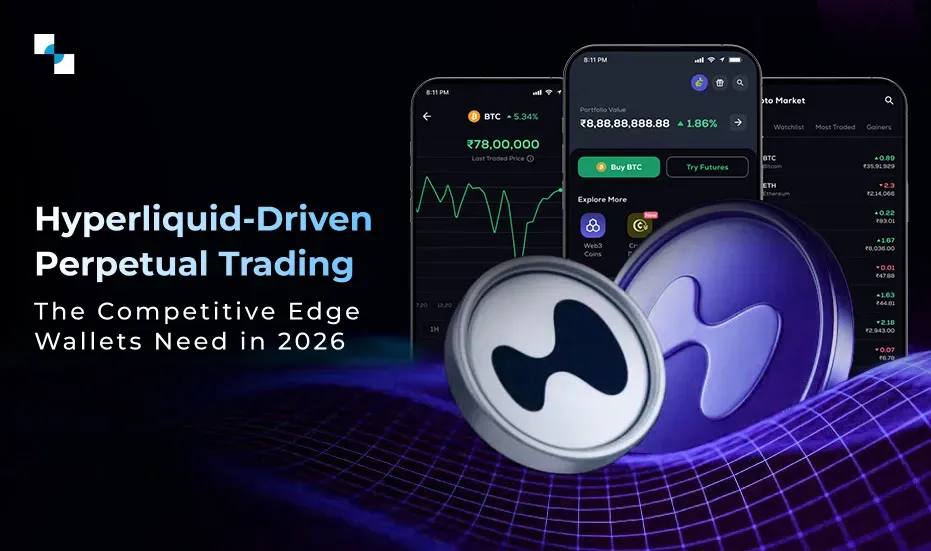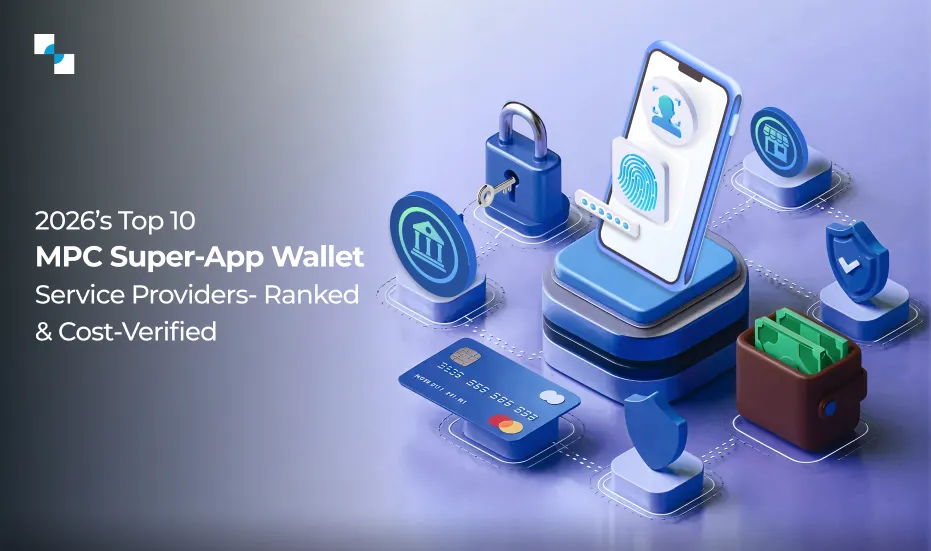The current bullish crypto market signals a pivotal moment for businesses and investors seeking strategic entry points into the burgeoning Web3 landscape. White-label Web3 wallet development on the Cosmos blockchain offers a compelling solution, boasting rapid deployment, custom branding, scalability, and interoperability inherent to its architecture.
Businesses or investors looking forward to investing in such wallet solutions are more likely to acquire advantageous propositions. Opting for white-label Web3 wallet development bypasses the time-intensive and resource-heavy process of in-house process, granting a competitive edge through faster market entry. Moreover, full branding control ensures a seamless user experience reflective of your business’s identity, fostering brand recognition and trust. However, harnessing the Cosmos blockchain’s interoperability and scalability empowers businesses to seamlessly engage with diverse blockchains, expanding market potential and optimizing user experience. Scroll through the blog to discover why white label Web3 wallet on the Cosmos blockchain is a preferred choice right now.
Why should businesses design a White-Label Web3 Wallet on The Cosmos Blockchain?
The burgeoning crypto market presents a compelling opportunity for businesses to enter the Web3 space. White-label Web3 crypto wallet offers a rapid and cost-effective solution, enabling brands to customize the user experience and establish a presence in this emerging landscape. Businesses should strongly consider designing white-label Web3 wallet on the Cosmos blockchain for several compelling reasons-
1. Customization and Control – White-label solutions grant businesses complete branding control, allowing them to integrate seamlessly into their existing ecosystem. This ensures a consistent user experience and enhances brand recognition.
2. Speed to Market – White-label crypto wallet eliminate the need for extensive development from scratch, significantly accelerating the time to launch. This provides a competitive advantage and enables businesses to capitalize on the rapidly growing Web3 market.
3. Cost-Effectiveness – Developing in-house wallets demands significant financial and resource investment. White-label solutions offer a more cost-effective approach, freeing up resources for core business operations and innovation.
4. Focus on Core Competencies – By utilizing white-label solutions, businesses can prioritize their core strengths instead of diverting resources towards wallet development and maintenance, ensuring a streamlined and efficient operational model.
5. Enhanced Security – White-label solution providers prioritize security, ensuring the protection of user assets, a paramount concern in the Web3 domain.
6. User Experience – Reputable white-label providers deliver intuitive interfaces and seamless interactions, fostering user adoption and satisfaction.
7. Reputation – Selecting a reliable white-label provider with a strong track record is crucial to ensuring a robust, secure, and user-friendly wallet experience.
Designing white-label Web3 wallet on the Cosmos blockchain presents businesses with a compelling opportunity to enter the Web3 space quickly, and focus on their primary strengths while leveraging the advantages of the Cosmos ecosystem. It is recommended to partner with an established white-label crypto wallet development company that leverages its expertise in blockchain technology and the cryptocurrency ecosystem, ensuring a secure, user-friendly wallet that thrives in the dynamic Web3 ecosystem.
20 Must-Have Features Of White Label Web3 Wallet Based On Cosmos in 2024
🔍Interoperability – Seamless integration with other blockchains through the Inter-Blockchain Communication (IBC) protocol. This empowers users to hold and manage assets across various chains without needing separate wallets, enhancing user experience and accessibility.
🔍Scalability – The Tendermint consensus mechanism enables high transaction speeds and scalability, crucial for accommodating a growing user base within the rapidly evolving Web3 space.
🔍User-Friendly Interface – Prioritize user experience with intuitive designs and streamlined interaction for both crypto enthusiasts and beginners.
🔍Mobile Accessibility – Ensure smooth operation and ease of use on mobile devices, catering to a global audience with diverse preferences.
🔍On-Ramp/Off-Ramp Integration – This allows users to easily convert fiat currencies to crypto and vice versa, simplifying entry and exit from the crypto market. This can be achieved through partnerships with reputable fiat gateways, ensuring secure and seamless transactions. You can use your debit or credit card to directly purchase cryptocurrency within the wallet. You can use your debit or credit card to directly purchase cryptocurrency within the wallet
🔍QR Code Functionality – Integrate QR code generation and scanning for quick and easy address sharing and receiving payments, enhancing user convenience and transaction efficiency.
🔍Multi-Signature Support – Implement multi-signature capabilities for transactions, requiring approval from multiple users before funds are disbursed. This adds an extra layer of security for shared accounts or high-value transactions.
🔍Integrated Marketplace – Explore the potential of integrating a marketplace directly into the wallet, allowing users to discover and purchase NFTs, DeFi products, and other Web3 services without leaving the platform, fostering user engagement and creating a more comprehensive experience.
🔍Biometric Authentication – Enhance security and user convenience by integrating biometric login methods like fingerprint and facial recognition.
🔍Advanced Encryption – Protect user data and private keys with cutting-edge encryption algorithms.
🔍Self-Custody – Maintain the fundamental principle of Web3, allowing users complete control over their digital assets and private keys.
🔍Multiple Chain Support – Enable interaction with various blockchains like Ethereum, Binance Smart Chain, and others, expanding user options and catering to a wider range of assets.
🔍Atomic Swaps – Integrate the ability to directly trade assets between different blockchains within the wallet, simplifying cross-chain exchange and fostering user convenience.
🔍DeFi Integration – Simplify access to DeFi platforms for activities like lending, borrowing, yield farming, and liquidity provision, directly from the wallet interface.
🔍Yield Monitoring – Offer users insights into their DeFi investments, including transaction history, portfolio performance, and real-time yield tracking, promoting informed decision-making.
🔍NFT Management – Integrate functionalities for viewing, purchasing, selling, and trading NFTs effortlessly within the wallet, catering to the growing NFT market and enhancing user engagement.
🔍Ecosystem Integration – Facilitate seamless interaction with the broader blockchain ecosystem, including decentralized exchanges (DEXs), Decentralized Autonomous Organizations (DAOs), and blockchain-based identity solutions.
🔍Cross-Platform Compatibility – Ensure consistent access and interaction with the wallet across various devices and platforms, regardless of user location or device preference.
🔍Comprehensive User Education – Offer in-app tutorials, educational materials, and security best practices to empower users and foster understanding of blockchain technology, Web3 possibilities, and responsible wallet usage.
🔍Responsive Customer Support- Provide efficient and timely support to address user queries, concerns, and potential issues, promoting user satisfaction and building trust.
By incorporating these features, white-label Web3 wallet built on the Cosmos network can offer users a comprehensive, secure, and user-friendly platform to the users. If you are planning to navigate the evolving Web3 landscape with white-label crypto wallet, then partner with a premium Web3 wallet development company that can help you inculcate all the mentioned features.

What Are The Technical Aspects of White Label Web3 Wallet Development on Cosmos?
White-label Web3 wallet development on the Cosmos blockchain involves various technical considerations beyond security features. Thus, it is always recommended to get in touch with a well-established Web3 wallet development company that boasts qualified and skilled blockchain experts who are adept at designing such wallet solutions. Let us explore the various technical key aspects of the development process-
1. Leveraging the Cosmos SDK :
- Pre-built Modules : The Cosmos SDK offers pre-built modules for common functionalities like account management, token handling, and governance. This minimizes development time and promotes code standardization.
- Customizable Modules : While core functionalities are provided, the SDK also allows customization of modules to tailor the wallet to your specific needs and brand identity.
2. User Interface (UI) and User Experience (UX) Design :
- Focus on Usability : Design an intuitive and user-friendly interface that caters to diverse user experiences and technical backgrounds.
- Cross-Platform Compatibility : Develop the wallet for web, mobile, or both, depending on your target audience and their preferred access methods.
- Integration with Existing Systems : Consider seamless integration with existing infrastructure or partner services for a smooth user experience.
3. Security Implementation :
- Secure Key Management : Implement robust methods for storing and managing user private keys, potentially integrating with hardware wallets or using secure enclaves.
- Multi-Factor Authentication : Enforce additional verification steps beyond passwords, like one-time codes from authenticator apps, for stronger access control.
- Secure Communication Channels : Employ encryption protocols (HTTPS, TLS) for all communication between the wallet and external services, protecting sensitive data transfers.
4. Integration with Cosmos Ecosystem :
- Connection to Cosmos Hub : Establish a connection to the Cosmos Hub to enable interaction with the central network and various connected blockchains.
- Inter-Blockchain Communication (IBC) : Integrate the IBC protocol to facilitate the seamless transfer of assets between different blockchains within the Cosmos ecosystem, providing users with greater flexibility.
- Integration with Relevant dApps : Explore potential partnerships and integrations with popular applications within the Cosmos ecosystem to expand wallet functionalities and user utility.
5. Integration with White-Label Provider’s Services :
- API Implementation : Connect to the white-label provider’s APIs to access their core wallet functionalities and features.
- Customization Options : Utilize the provider’s tools and templates to customize the wallet’s branding, user interface, and features according to your requirements.
- Deployment and Maintenance : Work with the provider to ensure secure deployment of the wallet and ongoing maintenance, including regular updates and security patches.
6. Testing and Quality Assurance :
- Thorough Testing : Conduct comprehensive testing throughout the development process, covering functionalities, security vulnerabilities, and performance across different platforms and devices.
- Bug Bounty Programs : Consider collaborating with the white-label provider or launching your bug bounty program to incentivize the discovery and reporting of potential security weaknesses.
- Independent Security Audits : Regularly engage independent security experts to conduct audits and identify potential security risks.
- Compliance with Regulations : Depending on your target market and user base, ensure the wallet adheres to relevant regulations and licensing requirements.
- Open-Source vs. Closed-Source Development : Decide on whether to utilize an open-source or closed-source development model based on your comfort level with code transparency and customization needs.
By carefully considering these technical aspects and collaborating with a reputable white-label crypto wallet development firm you can develop a secure, user-friendly, and feature-rich Web3 wallet based on the Cosmos blockchain.
Future Outlook: Design White-Label Web3 Wallet On Comos Blockchain
The prospects for white-label Web3 wallets developed on the Cosmos blockchain are incredibly promising. Cosmos is the blockchain of blockchains and has gained mass popularity recently due to its potential. Leveraging Cosmos’s robust interoperability, scalability, and autonomy, the crypto wallets could serve as the entry point for the widespread adoption of Web3 applications.
Envision a future where users effortlessly manage assets across various blockchains, engage with DeFi protocols seamlessly, and explore unique NFTs, all within a single, customized wallet aligned with a brand’s identity. As Web3 progresses, Cosmos-based crypto wallets will play a crucial role in minimizing barriers, strengthening security, and granting users unprecedented control and accessibility. This signifies more than just a transformation in wallets; it signifies a shift toward a fully interconnected Web3 environment, enabling businesses and individuals to engage with the blockchain ecosystem according to their preferences.
Shake Hands With A Premium White-Label Web3 Wallet Company
The bullish crypto market roars, and within its rumble lies a golden opportunity – white-label Web3 wallets built on the Cosmos blockchain. This potent combination offers a fast track into the future of finance, along with rapid deployment, seamless branding, and the inherent strength of the Cosmos network.
Are you also willing to be a part of this revolution? If yes, investing in a white-label Web3 wallet based on the Cosmos blockchain or any other premium network of your choice is a strategic approach. Connect with Antier, a leading crypto wallet development company specializing in delivering exceptional wallets such as Web3 wallets, NFT wallets, TRON wallets, etc. The seasoned blockchain experts of the company are well-versed in designing any crypto wallet on any popular blockchain network.







